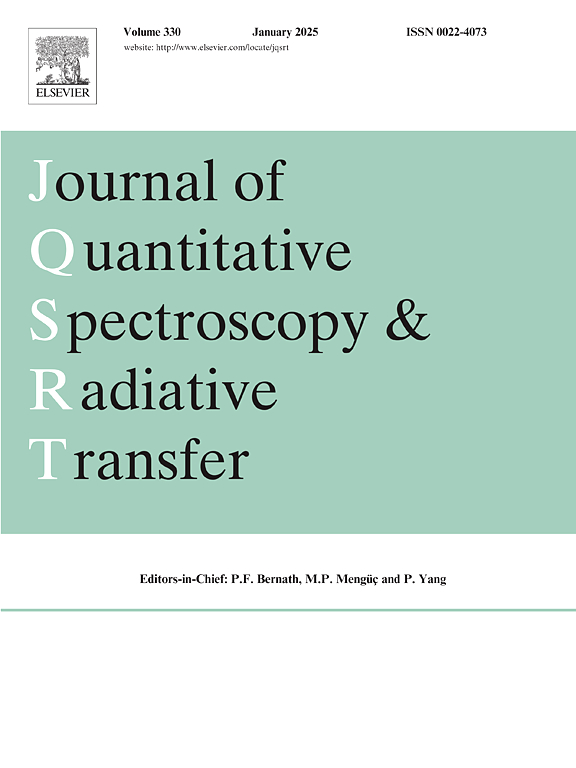Quantifying shortwave radiative forcing and heating rates of UTLS aerosols in the Asian summer monsoon anticyclone region
IF 2.3
3区 物理与天体物理
Q2 OPTICS
Journal of Quantitative Spectroscopy & Radiative Transfer
Pub Date : 2025-03-11
DOI:10.1016/j.jqsrt.2025.109430
引用次数: 0
Abstract
This study quantifies the shortwave (SW) direct radiative forcing and heating rates associated with the monsoonal aerosol enhancements in the upper troposphere and lower stratosphere (UTLS) over a broad spatial domain (25°N to 37.5°N and 40°E to 95°E) within the Asian summer monsoon anticyclone (ASMA) region. Using satellites and reanalysis data, we examine three dominant aerosol scenarios—sulfate, nitrate, and anthropogenic aerosols—and demonstrate that these enhancements induce a cooling at the top of the atmosphere (TOA), with radiative forcing estimates ranging from −0.13 to −0.19 Wm-2. Our analysis reveals increased upwelling SW fluxes at the TOA during the monsoon, with forcings reaching −0.2 Wm-2 relative to winter conditions. While both scattering aerosols (sulfates and nitrates) and absorbing aerosols (anthropogenic) contribute to TOA cooling, the magnitude of cooling from anthropogenic aerosols is comparatively smaller. Within the UTLS column (12–20 km), heating rates peak at 0.04 K day-1 for anthropogenic aerosols, while those associated with sulfate and nitrate aerosols remain significantly lower. Additionally, the study identifies key atmospheric changes during the monsoon, including elevated water vapor concentrations, reduced temperatures, and deceased ozone levels, both spatially and vertically, across the study domain. These findings underscore the critical role of Asian tropopause aerosols in shaping the regional radiation budget, emphasizing the need for their inclusion in future climate model assessments.
亚洲夏季风反气旋区UTLS气溶胶短波辐射强迫和升温速率的定量化
本研究量化了亚洲夏季风反气旋(ASMA)区域内宽空域(25°N至37.5°N和40°E至95°E)内对流层上层和平流层下层(UTLS)季风气溶胶增强相关的短波(SW)直接辐射强迫和加热速率。利用卫星和再分析数据,我们研究了三种主要的气溶胶情景——硫酸盐、硝酸盐和人为气溶胶,并证明这些增强导致了大气顶部的冷却(TOA),辐射强迫估计范围为- 0.13至- 0.19 Wm-2。我们的分析显示,季风期间TOA的西南偏南上升流通量增加,相对于冬季条件,强迫达到- 0.2 Wm-2。虽然散射气溶胶(硫酸盐和硝酸盐)和吸收气溶胶(人为)都有助于TOA冷却,但人为气溶胶的冷却幅度相对较小。在UTLS柱(12-20 km)范围内,人为气溶胶的升温速率峰值为0.04 K day-1,而与硫酸盐和硝酸盐气溶胶相关的升温速率仍显著降低。此外,该研究还确定了季风期间的主要大气变化,包括水蒸气浓度升高、温度降低和臭氧水平下降,这些变化在空间和垂直上都跨越了研究领域。这些发现强调了亚洲对流层顶气溶胶在形成区域辐射收支中的关键作用,强调了将其纳入未来气候模式评估的必要性。
本文章由计算机程序翻译,如有差异,请以英文原文为准。
求助全文
约1分钟内获得全文
求助全文
来源期刊
CiteScore
5.30
自引率
21.70%
发文量
273
审稿时长
58 days
期刊介绍:
Papers with the following subject areas are suitable for publication in the Journal of Quantitative Spectroscopy and Radiative Transfer:
- Theoretical and experimental aspects of the spectra of atoms, molecules, ions, and plasmas.
- Spectral lineshape studies including models and computational algorithms.
- Atmospheric spectroscopy.
- Theoretical and experimental aspects of light scattering.
- Application of light scattering in particle characterization and remote sensing.
- Application of light scattering in biological sciences and medicine.
- Radiative transfer in absorbing, emitting, and scattering media.
- Radiative transfer in stochastic media.

 求助内容:
求助内容: 应助结果提醒方式:
应助结果提醒方式:


